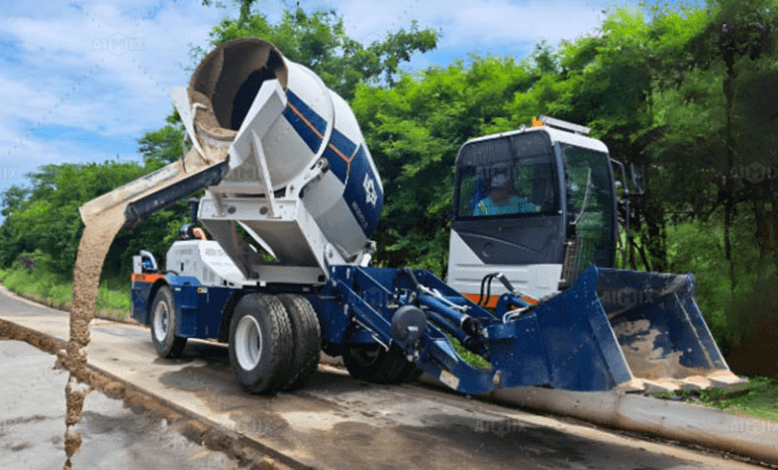The self loading concrete mixer is designed to overcome these limitationself loading concrete mixer: Advancing Modern Construction with Smarter Machinery

The construction landscape has seen an incredible shift in the past decade. From smart cities to rural development projects, the need for efficient and mobile concrete production has risen sharply. By combining concrete production, loading, transportation, and discharge in one robust unit, this mixer addresses many of the pain points that contractors face in the field.
As job sites grow more demanding and deadlines tighter, traditional concrete batching and delivery systems often fall short—especially in areas with limited infrastructure.
The Basics: What Is a self loading concrete mixer?
With a built-in loading bucket, rotating drum, operator cabin, and water system, this machine is capable of producing and delivering ready-mix concrete anywhere.
Its compact design and four-wheel-drive capability make it especially useful for off-road construction sites or urban areas with space constraints.
The Construction Industry’s Need for Self-Sufficiency
Many construction projects, especially those in developing regions or remote locations, suffer due to dependency on external batching plants and concrete suppliers. Inconsistent concrete quality, delays in delivery, and high transportation costs are just some of the issues that impact productivity.
A Self Loading Concrete Mixer empowers builders to take control of their concrete needs on-site. This independence translates into faster project execution, reduced overhead, and improved quality assurance.
See also: You Didn’t Know You Had A Lifeline: How To Get Emergency Bridging Finance
Step-by-Step Operation of a self loading concrete mixer
Let’s walk through a typical operation cycle to understand how this machine works in real-world conditions:
- Loading Raw Materials
The operator uses the front bucket to scoop cement, sand, and aggregates. These are automatically lifted into the mixing drum. - Water Injection
Water is pumped from the onboard tank using precise measurement controls. This step is critical for mix consistency. - Concrete Mixing
The drum rotates and mixes the contents until a homogenous concrete blend is achieved, typically in less than 10 minutes. - Transporting the Mix
The operator drives the mixer to the pouring location—be it 50 meters or 5 kilometers away. - Discharging Concrete
The drum rotates in the reverse direction to discharge the mix. In some models, the drum can rotate 270° or more for flexible unloading.
This streamlined process eliminates multiple steps, saves time, and ensures that fresh concrete is always available on-site.
Features That Drive Performance
Modern self loading concrete mixer models are packed with performance-oriented features:
- Electronic Weighing System: Helps maintain correct material ratios for quality output.
- Hydraulic Control System: Simplifies the bucket movement and drum rotation.
- User-Friendly Cabin: Ergonomically designed with joysticks, digital panels, and wide visibility.
- High-Performance Engine: Built for tough terrains and extended use.
- Sturdy Tires and Suspension: Ensures stability and off-road capabilities.
These features allow a single machine to handle operations that would traditionally need at least three separate machines and several workers.
Advantages for Contractors and Developers
Whether you’re building a small residential complex or a municipal bridge, the benefits of using a self loading concrete mixer are numerous:
1. Speed and Efficiency
Time delays in concrete delivery can stall a project. With on-site mixing, construction moves forward faster, reducing labor downtime and idle equipment.
2. Cost Savings
While the initial investment may seem high, the mixer quickly pays for itself. You cut down on material wastage, fuel costs, and external service fees.
3. Quality Control
Since concrete is mixed just before use, there’s minimal chance of setting or deterioration during transit. You get consistent and reliable mix strength.
4. Fewer Manpower Requirements
A single trained operator can manage loading, mixing, driving, and discharging. This reduces reliance on large crews and streamlines the construction workflow.
5. Improved Accessibility
The mixer can easily operate in narrow lanes, remote hillsides, or rugged farmland—places where ready-mix trucks can’t reach.
Practical Applications
The versatility of the self loading concrete mixer makes it valuable across a range of construction scenarios:
- Real Estate Development: Foundations, columns, and floors for residential buildings.
- Urban Infrastructure: Paving roads, drainage channels, and sidewalks.
- Bridge and Tunnel Projects: Delivers concrete inside confined construction zones.
Choosing the Right Mixer for Your Needs
- What kind of terrain will it operate on?
Opt for 4×4 or all-terrain wheels if needed. - Do you need advanced technology features?
Consider mixers with digital dashboards, GPS, or remote monitoring. - What level of service support is available?
Reputable brands like Daswell, Ajax, Fiori, and Carmix offer strong after-sales service and training. - Is operator training provided?
Make sure the operator is familiar with safety, maintenance, and operational controls.
Conclusion
The self loading concrete mixer is more than just a machine—it’s a construction partner that offers speed, precision, and flexibility. As job sites become more complex and time-sensitive, this equipment becomes an essential investment for contractors who value autonomy and productivity.
Its ability to mix and transport high-quality concrete, reduce manpower, and function in rugged conditions makes it ideal for any forward-thinking construction project. In today’s competitive building environment, owning a self loading concrete mixer means taking control of your project’s most critical material—concrete—directly at the source.



